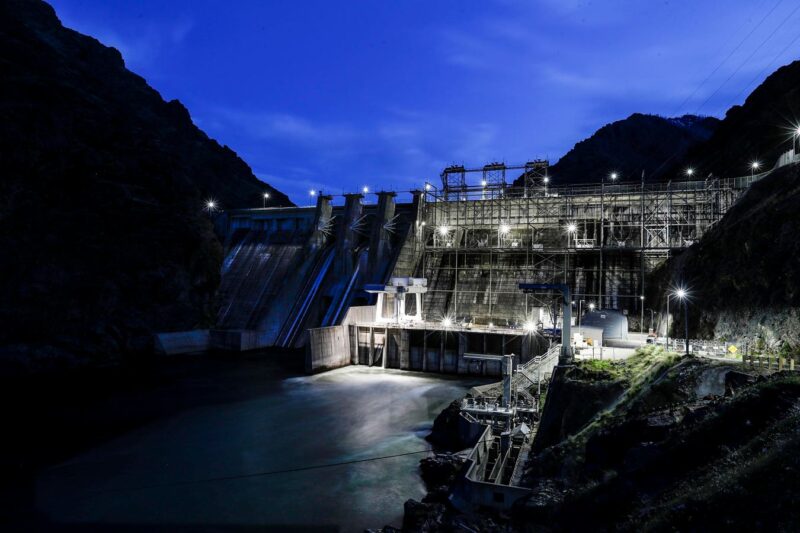Hells Canyon,Oregon, Wednesday, April 26, 2023- The Snake River rushes through Hell’s Canyon Dam as night falls. (Robert Gauthier/Los Angeles Times via Getty Images)
Los Angeles Times via Getty Images
The global economy runs on two invisible currents: water and energy. Most companies still manage them as separate problems — a costly oversight as droughts, grid strain, and data-center expansion collide.
A new analysis from Danfoss, a global engineering company best known for its energy-efficiency technologies, argues that we are overlooking the very infrastructure that could underpin our transition. In its latest Impact paper, the firm warns that the water sector already consumes around 4 % of global electricity and that demand could more than double by 2040 if nothing changes.
But more importantly, the paper reframes the challenge: this is not simply about scarcity or efficiency, but about turning water and energy into a unified system of resilience — leveraging technologies already available to unlock major savings, lower carbon and strengthen competitiveness.
“Water and energy are inseparable,” said Kim Fausing, the company’s president and chief executive. “We cannot solve one crisis without addressing the other. Beyond the immediate impact on our health, water scarcity also means that industries across the globe are struggling to access water for production. This poses a major challenge to industrial competitiveness. By reducing waste and improving efficiency, businesses save money, secure their operations, attract investment, and become more resilient.”
From Carbon To Continuity: The New Operational Risk
Energy makes up as much as 40% of a typical water utility’s operating expenses, and much of it is used to move or treat water that never reaches the end user because of leaks or inefficiencies. Fausing describes efficiency as “the single biggest lever for decarbonization,” adding that “it’s no longer an engineering challenge, as most of the solutions already exist.”
Danfoss’s analysis suggests that optimizing energy use in water systems and water use in energy systems could avoid more than 800 million tonnes of CO₂ emissions by 2040, while retrofitting wastewater plants with advanced energy optimization could save a further 300 million tonnes annually by 2030, roughly 10% of the EU’s emissions in 2023.
For companies, this is no longer an abstract sustainability issue. Droughts, power outages, and heatwaves are already halting production lines, delaying chip fabrication, and driving insurance costs higher. The next frontier of operational risk is not carbon itself but the stability of the resources that power and cool the modern economy.
Where Climate Impacts Collide
The warnings from industry are now being echoed by science, and by global risk bodies. The State of the Global Climate 2024 report, released by the World Meteorological Organization, identifies water as “the primary medium through which climate change impacts are felt.” It finds that more than 3.6 billion people already face water scarcity for at least one month each year, a figure expected to exceed five billion by mid-century. The report also notes that water-related energy use already accounts for up to 10% of national consumption in many countries, with emissions projected to rise sharply without coordinated efficiency and adaptation measures.
The WMO identifies a growing structural risk: 70% of all climate-related disasters are water-related, from floods and droughts to storms and landslides. Surface water storage has declined by roughly 1% per year since 2000, even as hydropower, thermal, and nuclear generation become increasingly constrained by temperature and flow variability. “Resilient societies will be defined by how well they manage the interdependencies between water, energy and climate,” the report concludes. Just recently, the UN’s Early Warnings for All Advisory Panel reinforced this urgency, calling for accelerated action to expand multi-hazard early warning systems and protect the billions now exposed to water- and weather-related risks.
Turning Efficiency Into Adaptive Capacity
The idea that efficiency can serve as a resilience strategy is beginning to gain traction. In most economies, energy demand in the water sector is rising faster than the efficiency of pumps, motors, and treatment systems. Danfoss estimates that if all desalination plants worldwide operated at today’s best available efficiency of about two kilowatt-hours per cubic meter, they could collectively save thirty-four and a half billion euros each year in energy costs and avoid 111 million tonnes of carbon dioxide.
The same applies to wastewater treatment, where variable-speed drives that modulate pump speeds in real time routinely cut electricity consumption by 20-30%. In Denmark, the Marselisborg wastewater plant now produces roughly twice as much energy as it consumes, turning a conventional utility into an energy-positive system. In distribution networks, digital leak-detection systems and pressure management can reduce losses by up to 40%. Despite short payback periods and proven technology, investment and policy coordination remain limited; less than 3% of climate finance currently targets water efficiency and data systems.
The WMO calls for “systems designed for flexibility, redundancy and cross-sector coordination” as the foundation of climate adaptation. That, in effect, is the infrastructure of resilience: not only building new capacity, but making the capacity we already have work harder, smarter, and cleaner.
Industrial Exposure And Opportunity
The convergence of water and energy risk is already visible in industrial sectors that depend on both. Data centers, for example, now consume an estimated 560 billion liters of water per year, a figure projected to double by 2030. Semiconductor fabrication plants, beverage producers, and chemical processors face similar exposure. By 2040, 40% of global chip-manufacturing capacity will be located in regions of high or extreme water stress. The next supply-chain disruption may not come from a shortage of components, but from a shortage of water to cool them.
Technological solutions do already exist. Closed-loop liquid-cooling systems use far less water and are at least fifteen percent more energy-efficient than traditional air-based methods. Similar retrofits across industrial facilities could drastically reduce both water and power consumption. Yet the incentive structures lag behind the technology. Energy efficiency is often treated as an operating issue, while water management sits with environmental or compliance teams. That institutional separation prevents companies from recognizing the shared payoff.
The Economics Of Waste
The economic argument for efficiency is as strong as the environmental one. In the United States, leaking water infrastructure lost an estimated $7.6 billion worth of treated water in 2019. Because that water has already been pumped, filtered, and often heated, every cubic meter lost represents both financial waste and unnecessary emissions. Globally, the International Energy Agency projects that the energy used to move and treat water will increase faster than total electricity demand unless large-scale efficiency gains are made this decade.
The Danfoss report calls efficiency “the new infrastructure.” Eliminating waste boosts capacity and reliability while cutting emissions. It is a quiet revolution, less about new megaprojects than about making existing systems perform smarter. Those same operational gains are now drawing investor attention.
The Market Opportunity
Rising electricity demand, driven in large part by AI and the rapid roll-out of data centres, is translating directly into higher water use, since nearly every new megawatt of generation and cooling carries a water footprint. The IEA expects global electricity use to grow close to 4% annually through 2027, explicitly fuelled by the worldwide expansion of data centres. As this digital build-out accelerates, its water impact is drawing scrutiny. GRESB has flagged data-centre cooling water as a fast-emerging ESG risk.
For investors the implication is clear: the intersection of energy, water and digital infrastructure is evolving into a significant risk-opportunity frontier. They are channeling capital into closed-loop and liquid cooling, leak-detection and pressure management, real-time monitoring, and water-reuse systems that cut both power and water waste.
Meanwhile, frameworks such as the ISSB and EU CSRD now require companies to disclose their water–energy interdependencies, turning that nexus from an operational detail into a material valuation factor.
The Policy Blind Spot
Governments face a similar coordination problem. The WMO report notes that water and energy ministries “rarely share data or planning frameworks,” and that tariffs, subsidies, and performance targets are typically developed in isolation. As a result, opportunities to align incentives are routinely missed. The organization recommends that countries integrate water-energy data systems into national adaptation plans, invest in early-warning and monitoring infrastructure, incentivize “water-smart energy and energy-smart water” through regulation and pricing, and expand support for nature-based storage and recharge systems to stabilize both basins and grids.
For policymakers, this means treating water-energy efficiency as an adaptation priority, not simply an environmental goal. For investors, it underscores the materiality of the nexus: operational resilience, cost management, and emissions performance are intertwined.
The Hidden Infrastructure Of Resilience
Resilience has become a buzzword in business and policy circles, but its meaning is often diluted. The WMO’s framing restores its substance – adaptive and resilient infrastructure is not just about building higher sea walls or larger reservoirs; it is about embedding flexibility and redundancy into the systems that sustain life and commerce. When water and energy are managed together, the result is a network that can absorb shocks rather than amplify them.
The cheapest new supply of both water and energy is the waste we eliminate. Every liter saved in a network or industrial process means less pumping, less treatment, less exposure to energy volatility, and fewer emissions. Efficiency may be unglamorous, but it is the foundation of resilience. As the WMO notes, societies that manage these interdependencies best will define whether they thrive or falter in a climate-constrained world.









